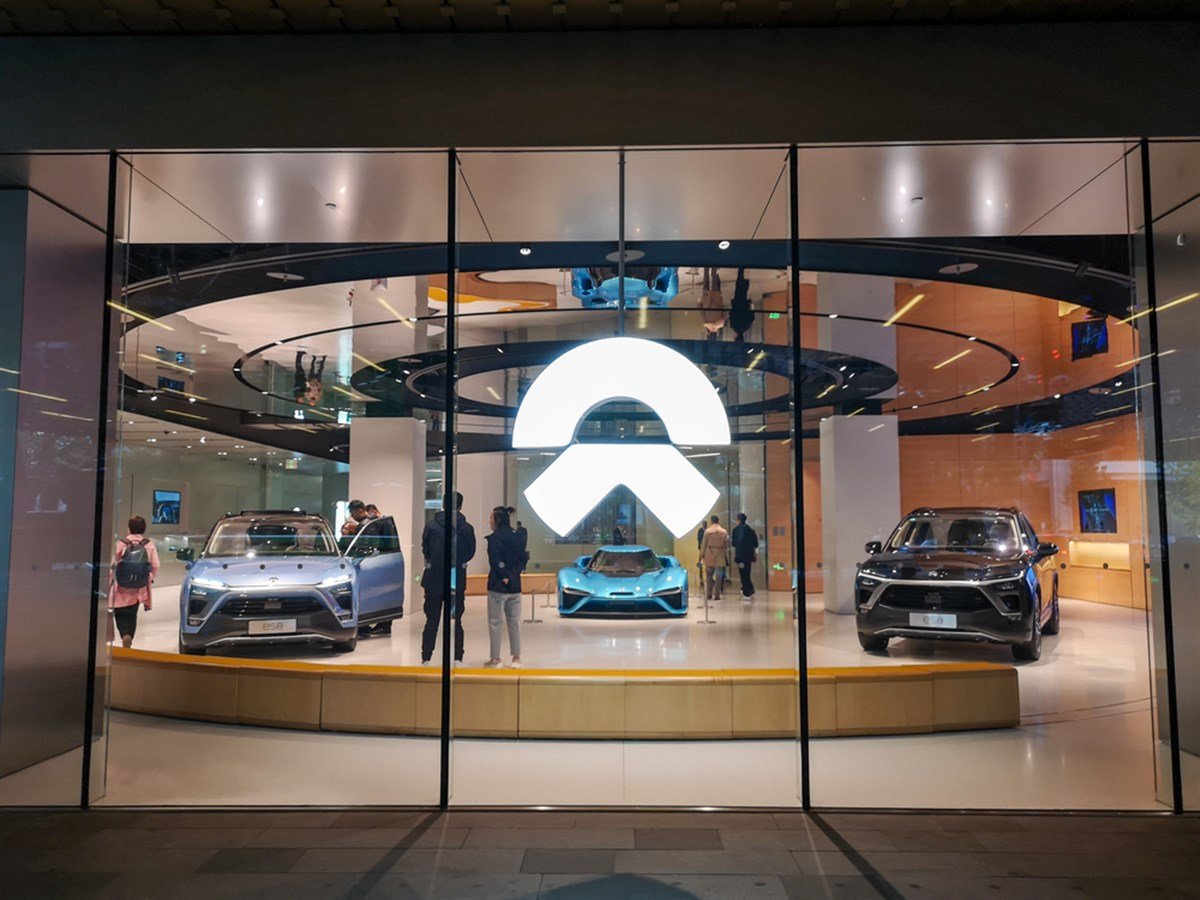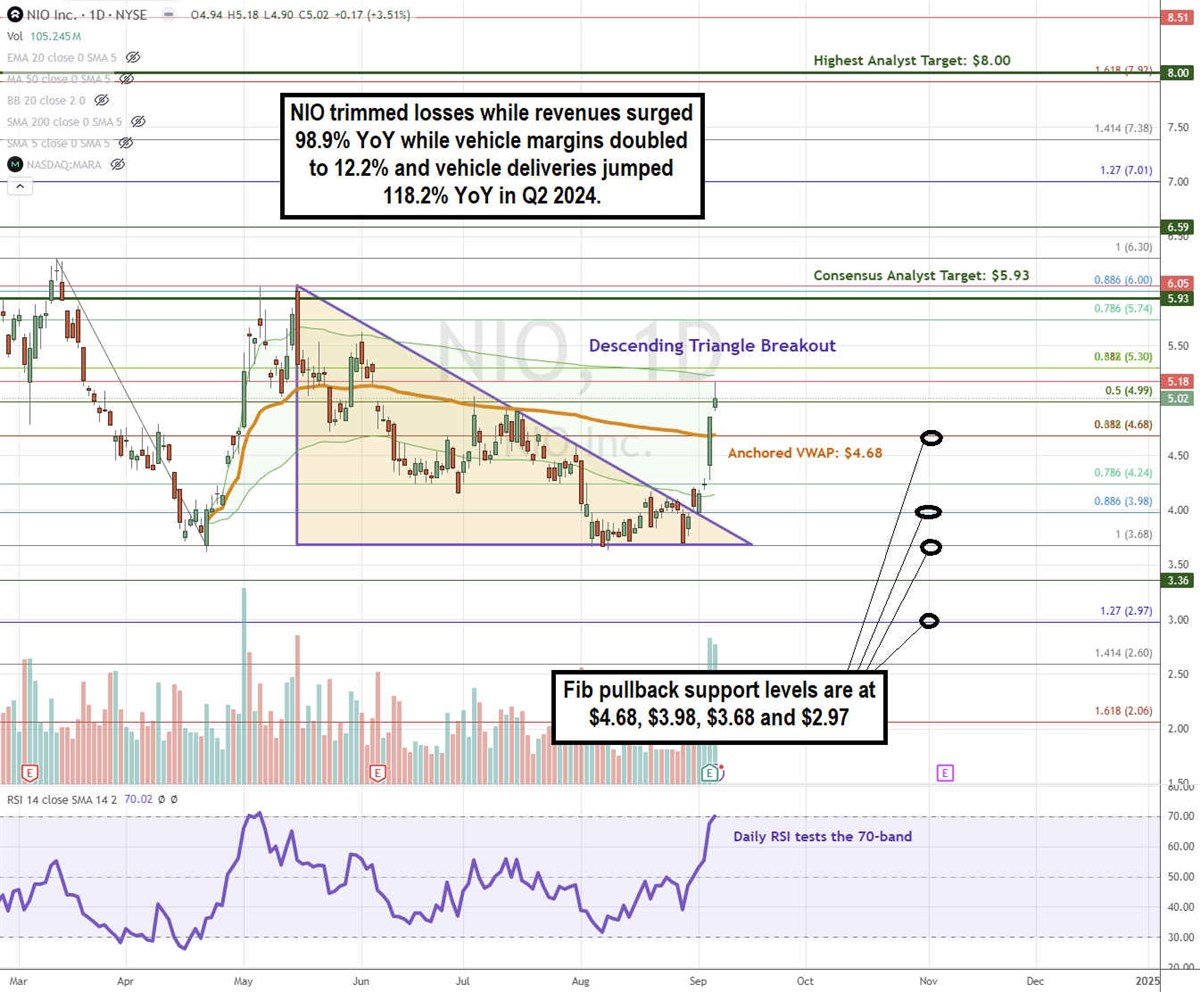
NIO Inc. (NYSE: NIO) is a Chinese electric vehicle (EV) manufacturer that sells sleek cutting edge EVs mainly in China. Shares have been battered as the company continues to post losses without a clear-cut path to profitability. However, there are signs of a potential turnaround as vehicle margins are starting to improve. While the core emphasis of NIO is focused on its EV models and delivery numbers, NIO is simultaneously growing in another niche of the EV infrastructure buildout, battery swapping stations, also called power swap stations.
NIO operates in the auto/tires/trucks sector, competing with other Chinese EV makers, including Xpeng Inc. (NYSE: XPEV), Li Auto Inc. (NASDAQ: LI), and ZEEKR Intelligent Technology Holding Ltd. (NYSE: ZK).
Power Swap Stations Are a Game Changer
NIO introduced battery swapping stations in 2018. Battery swapping is a much quicker way to replenish the power in an EV. Rather than wait 30 minutes to an hour for an EV to charge at a charging station, users can have their EV batteries swapped out for a fully charged EV battery automatically by a robot in three minutes while they wait. This method saves time and alleviates concerns over battery degradation and the inevitable expense of having to replace the expensive lithium-ion EV battery, which can cost up to $20,000.
BaaS Operating Model Means Cheaper EVs
An EV’s battery can account for nearly 19% of an EV’s total purchase price. EV batteries degrade over time and will ultimately have to be replaced. A battery-swapping station model alleviates those worries. It also cuts the cost of an EV by up to 20% since BaaS subscribers purchase their NIOs without a battery.
Here’s How a Nio Power Swap Station Works
NIO has created a revolutionary battery-as-a-service (BaaS) model similar to the razor-and-blade model, but rather than sell the blade, they sell you the car and rent out the battery.
Under the BaaS model, consumers would purchase a NIO EV without a battery, which saves them nearly $10,000 in upfront costs. The consumer signs up for a BaaS contract for around $1,760 per year. The customer pays a $11 to $14 fee each time they swap out the battery, which is comprised of the swap charge and electricity cost. The swap station also performs a battery and drive system diagnostic during the swap. Everything is performed automatically and robotically. Pricing varies depending on which plan the consumer chooses, which also includes battery upgrades and leasing options.
Building Out the Power Swap Station Infrastructure
NIO has built over 3,000 power swap stations in China in over 2,200 cities. They have evolved to its 4th generation Power Swap Station 4.0, enabling power swaps with other EV brands. Its 4.0 stations are 22% faster than the 3.0 stations as they can complete an automatic battery swap in under three minutes, or 144 seconds, to be exact. Each 4.0 station can accommodate 23 batteries completing up to 480 swaps per day. NIO has the largest battery swapping and battery charging network in China, which is comprised of more than 22,600 chargers.
Sidestepping Chinese Tariffs?
If NIO’s battery swapping stations are constructed in the United States, they would generally bypass import tariffs. NIO has stated its goal of building over 1,000 battery-swapping stations outside China. These battery-swapping stations are not exclusive to NIO’s EVs. Its latest generation of Power Swap Stations is designed to be compatible with multiple EV brands. This would be a soft-sell way of introducing NIO to the American consumer, which is still generating revenues for American EV users.
NIO’s Fundamentals Are Improving Rapidly
NIO reported a second-quarter 2024 adjusted net loss of $624.1 million, a 16.7% YoY decrease from the year-ago period. Revenue surged 98.9% YoY to $2.4 billion. Vehicle sales rose 118.2% YoY to $2.158 billion. Vehicle margin improved to 12.2%, nearly doubling the 6.2% margin in Q2 2023. Gross margin improved to 9.7%, up from 1% in the year-ago quarter. NIO closed the quarter with $5.7 billion in cash.
Vehicle deliveries surged 143.9% YoY to 57,373 units in the quarter, consisting of 32,562 premium smart electric SUVs and 24,811 premium smart electric sedans.
NIO Issues Upside Third Quarter 2024 Forecasts
NIO expects Q3 2024 deliveries between 61,000 and 63,000 units, up 10% to 13.7% YoY. Total revenue is expected to be around $2.63 billion, up 0.2% to 3.2% YoY.
NIO CEO and Chairman William Bin Li commented, “At the AI-themed NIO IN 2024, we unveiled major technological breakthroughs across multiple domains, including the in-house developed intelligent driving chip, full-domain vehicle operating system, smart system and intelligent driving. Through sustained and dedicated investment in technological research and development, NIO has positioned itself at the forefront of product and technological innovation, while achieving long-term cost competitiveness.“
Analysts Are Stepping Up to the Plate
NIO knocked the proverbial ball out of the park. Analysts took notice. JP Morgan upgraded NIO stock to Overweight from Neutral with an $8.00 price target, citing improving financials, improved cash position, and operational turnaround. Citigroup placed NIO on its 30-day upside catalyst watch. Wolfe Research resumed coverage with a Peer Perform rating.
NIO Stock Breaks Out of a Descending Triangle Pattern
An ascending triangle forms when a flat-top resistance upper trendline converges with an ascending lower trendline at the apex. This triangle represents the immovable object, the flat-top resistance price level, and the unstoppable force, rising bids.

NIO formed its descending trendline after peaking at $6.05 capping bounces at lower highs. The flat-bottom lower horizontal trendline formed at $3.68 as a floor for falling prices. The channel tightened into the earning release and triggered a breakout on the robust results. NIO surged through the $3.98 descending trendline resistance through the anchored VWAP at $4.68 to peak at $5.18. The daily relative strength index (RSI) has risen to the 70-band. Fibonacci (Fib) pullback support levels are at $7.31, $6.86, $6.59, and $6.29.
NIO’s average consensus price target is $5.93, and its highest analyst price target sits at $8.00.
Actionable Options Strategies: Bullish investors can buy using cash-secured puts at the fib pullback support levels to buy the dip and write covered calls to execute a wheel strategy for income. A less capital-intensive way to enter and collect income is to buy an in-the-money (ITM) LEAP call and sell out-of-the-money (OTM) front-month contracts against it to execute a Poor Man’s Covered Call (PWCC) strategy.













